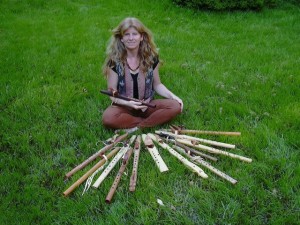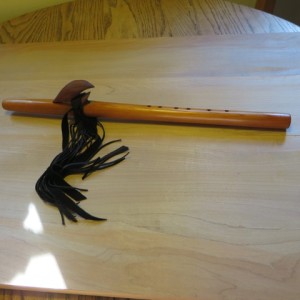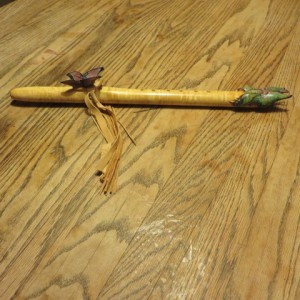It is a haunting sound, ancient as the peoples who lived out their lives in the forests and on the plains of the North American continent thousands of years ago, a plaintive call of eerie beauty, evocative both of human longing, and of the dark, sweet mysteries of nature itself. This is the sound of the North American native flute, and it is a sound you can hear today, deep in the heart of the Cowichan Valley on Vancouver Island.
It seems natural that these flutes should be made here, in the ancestral homeland of the Cowichan peoples, a land of forests, rivers and lakes. Here the sound of the flute echoes through the cedars, like the spirit of the forest itself, and floats across the lake with the primordial purity of the call of a loon.
Rommy Verlaan calls the music of these flutes “heart song”, and in her workshop on a rural property along the shore of Cowichan Lake, she works with precision and artistry to craft these beautiful instruments. Each one is unique and is destined to help someone give voice to the longings of the soul.
Also called Lakota flutes, or love flutes, Sioux legend has it that the first North American flute was made by a young Lakota man living on the Dakota plains. Despairing of being able to win the heart of the young woman he desired, the youth travelled deep into the woods to be alone with his feelings, and to seek inspiration. As he slept, Woodpecker pecked holes in a branch and the wind blew through the holes making a beautiful music that lifted the young man’s despair, giving him hope. Guided by Woodpecker, he cut down a branch and fashioned a flute. When he played it for the woman he loved, she was immediately drawn to him; and from that time forward the young Lakota men played flutes to court their love interests.
It took Rommy three years of research and experimentation to learn how to craft the exquisite flutes she sells today. She uses mostly local woods, such as red and yellow cedar and arbutus, but also some more exotic woods, such as purple heart, and ebony. Each wood is slightly different to work with, and has different acoustical properties, with the harder woods resulting in a brighter sound, the softer woods a more plaintive, soulful sound.
The construction of the flute requires careful work. Rommy hollows out the two longitudinal halves with a router. Then she hand carves the mouthpiece and creates what she calls a brass nest, which divides the flute into two chambers. The air blown into the first, smaller chamber will be directed through a hole, over a brass plate, and then out through the “true” sound hole into the second, or resonating, chamber of the flute. The wood must be meticulously carved on either side of the brass plate at the precise angles required to create the “sweet spot” that ensures optimal sound quality. Rommy uses a succession of files of different thicknesses, often finishing with a nail file at the end, since the result she is seeking is “give or take a hair”. Once the first chamber is completed, Rommy glues the two long halves of the flute together and planes the flute down by hand.
The block, or totem, sits on top of the flute, sealing the channel Rommy has created in the first chamber. This is an aesthetic feature of the flute, as well as a key functional element. Rommy carves loons and whale totems, and sometimes her partner, Zak, a well-known luthier, will carve totems of other animals. The totem is tied onto the flute with a leather strap handmade by Rommy.
Establishing the key and tuning of the flute is the next challenge. Rommy’s flutes are all in minor pentatonic keys, and placing and creating the holes is slow, deliberate work. Rommy starts with the bottom hole, placing it according to the mathematical formula that determines the required pitch and continues working on sizing the hole until it is perfectly tuned to her electronic tuner. She then works her way up the flute, creating, and tuning, each subsequent hole.
She finishes most flutes with walnut oil or tung oil, initially, and also with homemade varnish, or with bees wax and mineral oil. Rommy also makes the beautiful lined, cloth bags that come with the flutes.
Apart from the aesthetic appeal of the instruments, the fact that they are easy to play is one of the things that Rommy thinks draws people to her flutes. Rommy believes, however, that there is an even deeper appeal. She believes that when people hear the haunting, soulful sound of the Lakota flute, it resonates somewhere inside them, “connecting them to that soulful part of themselves, to an ancestral voice from which we have become disconnected.” Time and again, she hears that the purchase of one of her flutes has launched someone on a journey of self-discovery. For Rommy, knowing that her creative endeavours are contributing to something so life-affirming is one of her greatest satisfactions as an artist.
It is ten years since Rommy started selling her first flutes at the Duncan market. The challenge of surviving as an artisan, according to Rommy, is at the same time the secret to success: perseverance. She has learned to accept that there is a cycle of ups and downs: “If you really believe in what you doing, then trust in the flow of it. Trust your instincts … Don’t worry about looking at what others are doing: focus on doing what feels right for you.
Learning to make Lakota love flutes has launched Rommy on a rewarding journey. She has learned how to use tools to create a precision instrument out of wood, something she never anticipated herself doing. In addition, her flutes have given her the gift of music. Not previously a musician, she has learned how to play the flutes she makes, and now gives workshops twice a year, teaching others.
Rommy currently makes approximately 60 flutes a year. They range in price from $275 for a cedar flute to $2000 for an exquisite ebony flute, with a bear totem carved from a walrus tusk. Her flutes have found homes locally, and in the United States, Scotland, France, Japan, England and Australia. You can find Rommy and her flutes at the Duncan market, or view her work online at Heart Song Flutes.
 Deborah Graham
Deborah Graham
Email Deborah
See all articles by Guest Author







